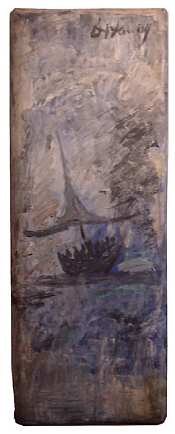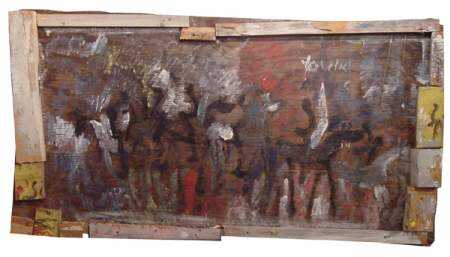Dressed
in a paint-splattered Hawaiian shirt, Purvis Young is relaxing
in an Adirondack chair at his studio in Ft. Lauderdale just
28.5 miles north of his studio in his town of Miami -- a place
he longs to return to once his law suit with former business
associate, Martin Siskind, is settled. The brilliant sunshine
is no match for the smile on Young’s face. He is five
months past his kidney transplant, feeling fit and looking far
younger than his 64 years. He’s painting and there’s
lightness in his voice, his touch and his being that hasn’t
been there in decades.
The Rubell’s have recently donated 90+ pieces of Young’s
work to the Tampa Museum of Art where they’ll be on exhibit
until July 22, 2007. Other retrospectives are in the works as
are major books chronicling Young’s career. Purvis
of Overtown, released in 2006, is a superb documentary
that has already garnered several well-deserved film festival
awards.

Young
is thankful for what he views as a second chance to do right
by his father and the world around him. He is tired of listening
to others and painting what they want – it’s his
time to paint what he wants, how he wants. “I can't solve
the world's problems. I paint the world's problems,” says
Young.
In considering Young’s work, William Arnett, an expert
in African American vernacular art and co-editor of Souls
Grown Deep, Volume’s I and II (along with son Paul
Arnett) says, “Almost every day, Young searches the streets
of Overtown for materials to incorporate into his artwork. Young’s
paintings are more than paintings. They are assemblages made
from an array of urban detritus carefully selected by the artist
according to his sense of their aesthetic and philosophical
compatibility. His haul may include plywood, broken furniture,
mirrors, window shades, carpet scraps, splintered wood, metal
trays, record albums, wallpaper samples, glass and paper correspondence,
manila folders, bank statements, bills, memos -- thrown away
by small manufacturing plants and offices still remaining on
the fringes of the community. The materials are chosen for more
than texture, colour, and form: Young considers each object’s
original use, and in his final creation -- gathered, selected,
arranged, nailed or glued together, painted, and framed -- each
component carries its own subtle and highly esoteric definition.”

Environmentally
conscious and unwilling to contribute to further deforestation,
Young's canvases are made of recycled products including found
wood, discarded library books, old political posters, used furniture
and various surplus items from construction sites. Young's paint
includes latex, acrylic, enamel and combinations of new paint
blended with the old that he has had for over 25 years.
 For
decades people -- including Robert Man and ‘Papa’
-- have brought Young what many would consider trash; however
the items are carefully culled according to the artist's specific
needs. Even though he has plenty of raw materials stored up,
he does not turn anyone away for in most cases they have walked
many miles with these heavy items in tow; and in the case of
Man and ‘Papa,’ they have been providing Young with
the materials for 40+ years.
For
decades people -- including Robert Man and ‘Papa’
-- have brought Young what many would consider trash; however
the items are carefully culled according to the artist's specific
needs. Even though he has plenty of raw materials stored up,
he does not turn anyone away for in most cases they have walked
many miles with these heavy items in tow; and in the case of
Man and ‘Papa,’ they have been providing Young with
the materials for 40+ years.
There
are many who say that Young is too prolific, but in his own
words, "people don't say that birds fly too much, that
Shakespeare wrote too much or that opera singers sing too much.
But, it don't bother me that they say I paint too much, I just
paint what I see and feel."
Dr. Bernard Davis (deceased in 1973), owner of the Miami Museum
of Modern Art, was among the first to collect Young's work and
sponsored his very first exhibition. Davis discovered the artist
in Goodbread Alley and became his champion, ensuring that he
was well-stocked with painting supplies.
 Out
of necessity, Young has developed a complex painterly langauge
in order to express what he sees and experiences in the world
around him in all its unpretentious stark reality. His symbols
convey the on-going economic and cultural divides so prevalent
in Miami and beyond, through recurring images of black and white
horses, pregnant women, highways and overpasses, convoys of
trucks and trains, railroad tracks, airplanes, angels and Zulu
warriors (whom he considers his tribe).
Out
of necessity, Young has developed a complex painterly langauge
in order to express what he sees and experiences in the world
around him in all its unpretentious stark reality. His symbols
convey the on-going economic and cultural divides so prevalent
in Miami and beyond, through recurring images of black and white
horses, pregnant women, highways and overpasses, convoys of
trucks and trains, railroad tracks, airplanes, angels and Zulu
warriors (whom he considers his tribe).
"My feeling was that the world might get better if I put
up my protests (in the form of paintings)," said Young,
in Bill Arnett's Souls Grown Deep: African American Vernacular
Art. "Even if it didn't, it was something I had to
be doing. I make like I'm a warrior, like God sending an angel
to stop war, like in my art."
In 2005, after 14 years of blindness in the left eye, surgery
performed by Dr. Carol L. Karp at Bascom Palmer Eye Institute
has restored Young's sight. Young also had a pacemaker installed
in 2006. Despite his varied illnesses, Young painted and studied
the world’s history without stopping, so consumed with
his art that he rarely saw the light of day.
*
* * * *
Born
on February 2, 1943 in Miami's Liberty City to Vera Mae Wright,
Young learned the art of drawing as a little boy watching his
maternal Uncle Irving, a figurative artist. This corrects the
previously held belief that Young is an outsider or self-taught
artist. His brother David, who passed away 10 years ago, was
a cartoonist and painter: clearly art is an integral part of
the family heritage.
Young
attended school up to the 8th grade during which time he swam
at Dixie Park (now called Gibson Park) and he was invited to
paint a mural on the Overtown Library, adjacent to the pool.
With the guidance of two of Miami-Dade Public Library System's
finest, Barbara Young (Librarian Curator of the Permanent Collection,
Art Services and Exhibitions Programs) and Margarita Cano (Administrator
of Community Relations), Young buried himself amongst the books,
hungry for knowledge that could explain the world to him.

Young,
who prefers to be known solely as a painter, has recently been
called an Urban Expressionist painter, a category much better
suited to his body of work. When thinking of an outsider artist,
the term generally reflects one who is naïve, isolated
and disassociated from contemporary life; none of these terms
is applicable to Young. The artist has spent countless hours
studying the masters, especially Rubens, Van Gogh and Delacroix.
He is passionate about the History Channel, Public Television,
National Geographic Magazine and CNN. He devours news and history
as a marathon runner gulps water – it is necessary to
his life and his work. "I was put on this earth to paint,
not to live," says Young.
For
the first 50 years of his life, Young remained within the county
lines of Miami. It was not until his 6th decade that he travelled
to other states and cities and learned that he was famous, a
fact he missed while art dealers encouraged him to seclude himself
in his studio.
"I always made my own money, didn't want anyone else to
pay for anything. I worked to support my habit and my habit
is painting," explains Young. "There was an old man
who owned The Palate in Wynwood, a shop that sold artists’
materials. He was always very nice to me and I have never forgotten
this."
Young's common law wife has four daughters whom he has called
his own since they were little. Of the seven grandchildren,
two have already showed an interest in art.
Today, Young's work is in more than 60 public collections and
numerous private ones; in 2006 alone he had six exhibitions.
His work hangs in The Bass Museum of Art (Miami); American Folk
Art Museum (New York); The Corcoran Gallery of Art (Washington,
D.C.); High Museum of Art (Atlanta): Lowe Art Museum (University
of Miami); Museum of Fine Arts (Houston); New Orleans Museum
of Art; Philadelphia Museum of Art; the Smithsonian American
Art Museum among many others. On December 24, 2006, the Sun-Sentinel’s
Emma Trelles named the Boca Raton Museum of Art's Purvis Young
exhibition #1 in the art category for the year in South Florida
The Purvis Young Studio is located at 1753 NE Second Avenue,
Miami, Florida and with luck will re-open before the end of
2007. In the meantime, please call either 786-285-0034 or 954-254-2999
for an appointment to see Mr. Young’s work.
All images
© Purvis Young